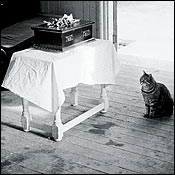
(Photo credit: Kent Gavin/Hulton Archive/Getty Images) |
Manny Mondaca pulls a small black cat out of its cage in a room where the walls are painted a comforting pastel blue. He lays the animal gently on a steel table covered by a soft quilt and scratches it behind its left ear. He strokes it a few times. He takes care to treat the cat especially kindly, because he is about to kill it. With Smooth Jazz 101.9 playing in the background, Mondaca’s colleague, Leticia Arroyo, picks up a hypodermic needle filled with a blue poison called “Fatal Plus.” It lulls an animal to sleep before it dies. The cat registers the needle’s soft entry into its belly with just a twitch of an ear.
Welcome to the new era of reduced-cruelty euthanasia. Mondaca is a technician with Animal Care & Control of New York City, the nonprofit that runs the city’s animal shelters, which take in more than 50,000 stray dogs and cats a year. Last year, it had to put down 23,745 of them. That’s the smallest number in AC&C?s history, thanks to adoption outreach and increased funding for spaying and neutering. The goal of the center’s director, Edward Boks, is to be “no-kill” by 2009. In the meantime, he’s instituted steps to make an animal’s passing a little easier. Shelters in some parts of the country still kill animals en masse with carbon monoxide, says Boks. And while many shelters use injections, he adds, most don’t bother with soft music, comfortable tables, and soothing wall colors. Some even allow doomed animals to witness another’s death. “Animals can sense fear in other animals,” Boks says.
These changes might actually be more about reducing cruelty for the humans performing the procedures. Some technicians at the shelter have trouble coping with their roles—one repeatedly became hysterical before euthanasia sessions. “Pastels might make the people feel better,” says Colorado State University animal-behavior expert Temple Grandin. Though she points out that relaxing the staffers could make the animal’s last moments more relaxed as well.
“Until we achieve no-kill,” says Boks, “we should create comfort in their last moments. This may be the first loving touch they’ve ever had—even if it’s their last.”
Does the pathetic story above make you sad for the cat? Is this a good way for its final, perhaps most loving moments to be spent? Some may think this a kindness, but then imagine the end-of-life drama this kind of thinking embraces: "Fatal Plus" would also be equally useful for old people, genetic defectives, unwanted children (before birth, after birth, most teenagers), illegal aliens, etc. After all, why shouldn't we try to "...create comfort in their last moments" just like we would for any pet? 'Here, Grandma, let me kiss you one last time...'
But what if there's a little - oops - to deal with?
The purpose of this archive is not to steal, but rather to preserve. I always give full credit to the original source and have no profit motive or incentive in presenting the above. A link to the original post is included below. The original content is unaltered and the original appearance differs [if at all] mostly in the welcome absence of pop-up windows and advertisements. Many of the outside links in the original article have been preserved as have most images (space allowing). Over the last few years the internet version of " Here Today, Gone Tomorrow" has become all too common. This archive is intended to act only as a backup resource in the event the original disappears. To jump to the original article, Click here
Return to Choice Cartoons Page
Return to Dan's Archives Page
Return to Dan & Sheryl's Home Page